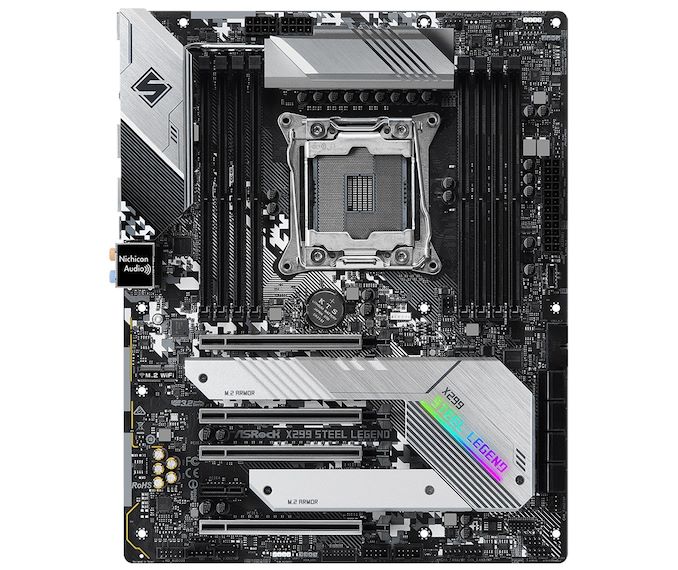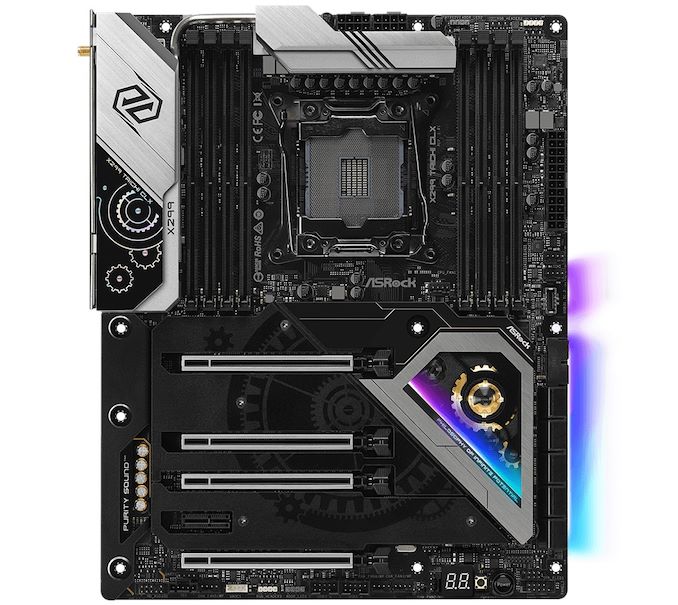ASRock Unveils Three New X299 Motherboards For Cascade Lake-X
by Gavin Bonshor on October 25, 2019 9:30 AM EST JPG_678x452.jpg)
With Intel's new Cascade Lake-X HEDT processors coming soon, ASRock has announced three new motherboards - the Steel Legend, the Creator, and the Taichi CLX. The trio is spearheaded by the high-end X299 Creator which is focused on content creators with features such as an Aquantia 10 gigabit Ethernet controller, Intel's Wi-Fi 6, three PCIe 3.0 x4 M.2 slots, and a whopping 10 SATA ports. The ASRock X299 Creator also has an Intel Thunderbolt 3 chip for with 40 Gbps Type-C connectivity.
ASRock X299 Steel Legend
Starting out with the ASRock X299 Steel Legend, it has four full-length PCIe 3.0 slots which run at x16/x4/x16/x8, with a single PCIe 3.0 x1 slot. Storage capabilities consist of two PCIe 3.0 x4 M.2 slots which also support SATA drives, with a total of eight SATA ports with support for RAID 0, 1, 5 and 10 arrays. Each M.2 slot includes an M.2 heatshield to keep hot running NVMe SSDs cool. The eight memory slots allow users to use up to DDR4-4200 with a total supported capacity of up to 256 GB.
For the networking is a pair of Ethernet ports on the rear panel, one powered by an Intel I219 V, and the other by an Intel I211-AT Gigabit controller. Also on the rear panel is two USB 3.2 G2 20 Gbps Type-C ports from an ASMedia ASM3242 controller, three USB 3.1 G1 Type-A, and four USB 2.0 ports. The audio is powered by a Realtek ALC1220 HD audio codec which controls the five 3.5 mm audio jacks and S/PDIF optical output. The aesthetic also follows previous ASRock Steel Legend models with a silver and grey design, with RGB LEDs integrated into the X570 chipset heatsink. The ASRock X299 Steel Legend also uses an 11-phase power delivery with a large aluminium heatsink connected to the rear panel cover which designed to keep it cool.
ASRock X299 Taichi CLX
ASRock has redefined its fabled and unique Taichi design with the new X299 Taichi CLX. Firstly ASRock has gone with a black Taichi inspired PCIe cover which dominates the lower portion of the PCB. Incorporated into the design is a contrasting silver chipset heatsink with a gold and black cogwheel design with integrated RGB LEDs. The new ASRock X299 Taichi CLX is using a 13-phase power delivery with a heat pipe connecting the heatsink within the rear panel cover to the large aluminium power delivery heatsink. Like the ASRock X299 Steel Legend, the X299 Taichi CLX also features eight memory slots with support for up to DDR4-4200 and allows users to install up to 256 GB. Looking at PCIe support, there are four full-length PCIe 3.0 slots which operate at x16/x8/x16/x8, with a PCIe 3.0 x1 slot also present.
The boards three PCIe 3.0 x4 M.2 slots share bandwidth with the second full-length slot and when populating a SATA based drive, the slot will operate at x4 mode, with an NVMe drive completely disabling this slot. A Realtek ALC1220 HD audio codec takes care of the boards onboard audio, while an assisting Texas Instruments NE5532 headset amplifier is present to bolster the quality of the front panel audio with support for headsets of up to 600 Ohms. A total of 10 SATA ports are present, with eight featuring support for RAID 0, 1, 5, and 10 arrays, while the other two ports are not controlled from the X299 chipset. Instead, these are powered by an ASMedia ASM1061 SATA controller. The networking consists of a Realtek RTL8125AG 2.5 Gigabit Ethernet controller, with a second port powered by an Intel I219-V Gigabit controller; the ASRock X299 Taichi CLX also includes an Intel AX200 Wi-Fi 6 wireless interface which also offers users with BT 5.0 connectivity.
ASRock X299 Creator
Finishing off with ASRock's new flagship X299 motherboard, the X299 Creator, its focus is on content creators with a strong high-end feature set. The ASRock X299 Creator has an Aquantia AQC107 Ethernet controller with an assist going to an Intel I219-V Gigabit controller, with an Intel AX200 Wi-Fi 6 interface providing both Wi-Fi and BT 5.0 connectivity. There are four full-length PCIe 3.0 slots which operate at x16/x8/x16/x8, with three PCIe 3.0 M.2 slots, and a total of 10 SATA ports eight of those supporting RAID 0, 1, 5, and 10 arrays.
ASRock hasn't unveiled the full specifications for the X299 Creator as of yet, and it's not likely to be cheap based on the price of ASRock's current flagship models. The ASRock X299 Creator, X299 Taichi CLX, and X299 Steel Legend models look set to be launched sometime in November, with no pricing information at present.
Confusing Naming Scheme: X299 Creator
One highly confusing aspect to ASRock's new X299 Creator comes in the name Creator; MSI has already announced an X299 Creator model. It's bad enough that Intel and AMD consistently make its chipset names similar such as B250 for Intel and B350/B450 for AMD which can confuse, and even mislead users. Both the ASRock X299 Creator and MSI X299 Creator focus the aim at the wallets of content creators, but both share the same model name which is sure to cause confusion among users. This is not only unacceptable in the modern market, it's worth noting that MSI used to call its content creator series models the 'Creation', with ASRock unveiling its first Creator model on the X570 chipset.
Related Reading
- Intel's Cascade Lake-X CPU for High-End Desktops: 18 cores for Under $1000
- GIGABYTE Unveils Three New 'X299X' Motherboards For Cascade Lake-X
- MSI's Motherboard Refresh for Cascade: Three New Professional X299 Offerings
- ASUS Unveils the ROG Rampage VI Extreme Encore X299 Motherboard
- New GIGABYTE X299-WU8 Workstation Motherboard: Dual PLX8747, but Built for Core-X?
- Intel's Next-Generation 'Cascade Lake-X' HEDT CPUs Due in October












10 Comments
View All Comments
Flunk - Friday, October 25, 2019 - link
Lack of PCI-E 4.0 in a ""high end desktop" system in late 2019 seems a bit rich. Intel is going to have to bargain bin this entire platform if even half the rumours about Threadripper 3 are accurate.FreckledTrout - Friday, October 25, 2019 - link
Excluding PCIe 4.0 Intel is going to have to lower prices drastically to sell any HEDT systems. The purpose of these is more cores, higher memory bandwidth, and more PCIE lanes which of course PCIe 4.0 doubles bandwidth effectively doubling lanes compared to PCIe 3.0. AMD has more of all the features all around. Looking at Intel's profits though its not hurting them at all as of yet but frankly anyone looking at 10+ cores would be silly to pick Intel right now especially with AMD's superior SMT.imaheadcase - Friday, October 25, 2019 - link
Except 4.0 is not needed for most people till a few years out..so yah..danielfranklin - Monday, October 28, 2019 - link
Given the lack of PCIE4.0 devices, the vast number of 3.0 devices, having lots of lanes is generally better than less 4.0 lanes. Not that Threadripper isnt going to have 4.0 AS WELL, just saying.Intel's pricing drops does change this greatly. Intel is still Intel, its a highly supported and well documented platform that will make its way into more OEM builds than Threadripper ever will.
It will do OK, but yes most BYO home builds will probably go AMD this year.
That said, there are plenty of X299 and Xeon-W boards in the world looking for some cheap 18 core goodness, i have a couple in my home :P
imaheadcase - Friday, October 25, 2019 - link
Um its perfectly fine in a high end system. You do know that just because something is new doesn't mean its needed right? Especially true with technology.PCI-E 4.0 is a long way from being needed.
a5cent - Monday, October 28, 2019 - link
You do know that PCIe 4.0 NVMe drives are already available and that they provide another substantial improvement in read performance, right?I'd say anybody doing things like video editing is making a mistake if they purchased a PCIe 3.0 board today. Anybody with two or more NVMe drives (where the second is hooked up to the chipset rather than the CPU), or anybody with a lot of simultaneous I/O would also benefit greatly from a PCIe 4.0 board.
For AMD, currently not getting a X570 board with PCIe 4.0 leaves only X470 or lower as alternatives. That is a PCIe 2.0 chipset, not PCIe 3.0, so at least for AMD, avoiding PCIe 2.0 means you must go PCIe 4.0.
Not everybody needs PCIe 4.0. Obviously, consumer gaming graphics cards won't benefit from it at all. That doesn't mean there aren't any reasons to go with PCIe 4.0 though.
Dug - Monday, October 28, 2019 - link
Not really. There is a reliability in bios, drivers, and optimizations that AMD motherboards still lack.Along with vrm differences in motherboards where you have to pay a fortune to get a good motherboard. (Along with another tiny fan) Although memory compatibility is much better now, it still has issues.
There is also the issue of heat and clearance issues because of huge heatsinks with pcie-e 4.0 ssd's right now that throttle unless heavily cooled. Especially when a Samsung 970 does surprisingly better in everything but large file transfer. And even then, 4GB are common but only a couple of seconds difference. Not worth the extra heat and unknown reliability.
firewrath9 - Friday, October 25, 2019 - link
"whopping 10 SATA ports"Didn't ASRock make a Z87 mobo with 22 SATA Ports?
I'd love to see perhaps a X299 board with like 10 M.2 slots
danielfranklin - Monday, October 28, 2019 - link
That's already one of the best things about this platform, cpu based PCIe for NVME as well as a video card, who would have thought...You can run multiple 4xM.2 cards in these systems, all right off the cpu. More bandwidth than you would ever know what to do with. Would have taken 10 racks 15 years ago for that kind of IO!
M O B - Sunday, October 27, 2019 - link
An ASRock X299 SAGE/10G board would be appreciated. Those extra few lanes should be helping here, but I'm not seeing any better looking I/O.